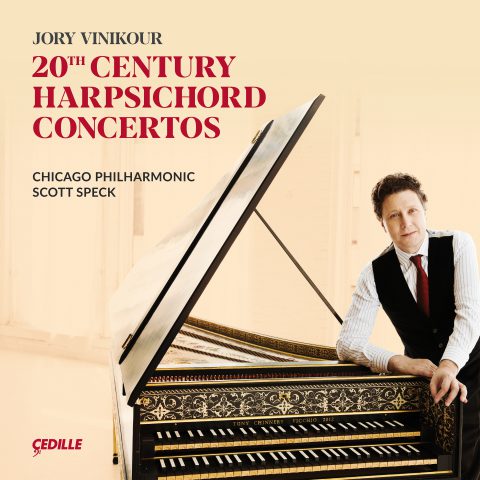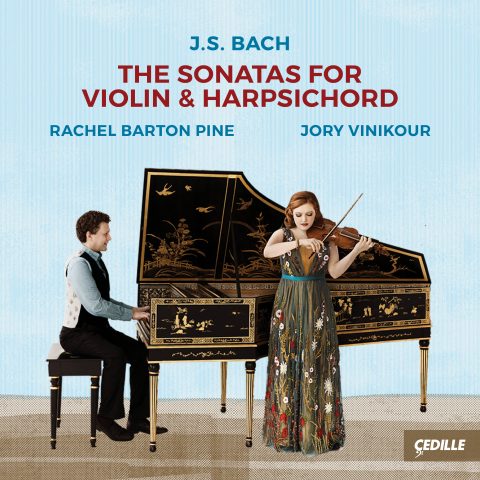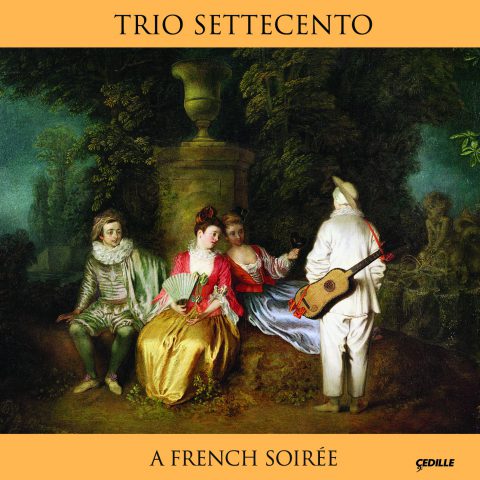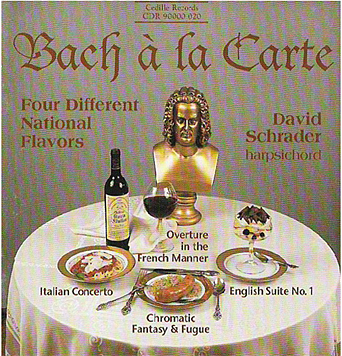Store
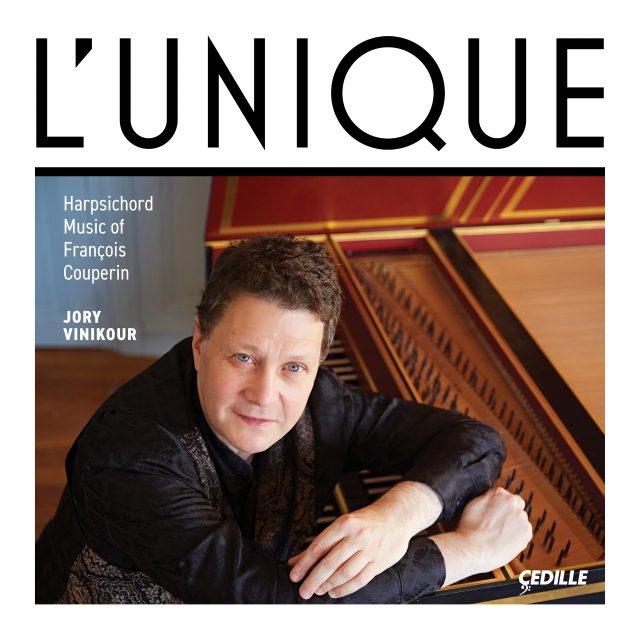
Store
L’Unique — Harpsichord Music of François Couperin
Two-time Grammy Award-nominated harpsichordist Jory Vinikour plays historically groundbreaking works by François Couperin (1668–1733) on an album comprising three inventive Couperin suites — the composer called them “Ordres” — combining traditional French Baroque dance movements with witty and atmospheric character pieces — miniature tone poems for solo harpsichord.
Couperin’s suites “are elegantly composed, concealing a complex, allusive and varied emotional world behind their highly wrought surface” (Norton Grove Concise Encyclopedia of Music).
Chicago-born, French-trained harpsichordist Vinikour is especially enamored of Couperin’s Ordres Nos. 6, 7, and 8, calling them “remarkable” for their harmonically driven melodic invention and atmospheric unity within each suite.
Highlights include the celebrated Les Baricades Mistérieuses from Ordre No. 6, which England’s The Guardian calls “shimmering, kaleidoscopic and seductive, a sonic trompe l’oeil.” The compelling Les Amusemens from Ordre No. 7 is irresistibly sweet and melancholic. Order No. 8 offers masterful examples of established forms, culminating with a dramatic Passacaille.

Listen to Jim Ginsburg’s interview
with Jory Vinikour on Cedille’s
Classical Chicago Podcast
Preview Excerpts
FRANÇOIS COUPERIN (1668–1733)
Sixième Ordre
Septiême Ordre
Huitiême Ordre
Artists
Program Notes
Download Album BookletL' Unique — Harpsichord Music of François Couperin
Notes by Julien Dubruque
Philippe Beaussant remarked on François Couperin (1668–1733), “there is nothing to say about his life.” Like Bach, Couperin belonged to a long line of musicians who, from father to son, held the same responsibilities, including serving as organist at Paris’s Saint-Gervais church from the 17th to 19th centuries. His father Charles and his uncle Louis attained the highest positions in court. François himself is the most eminent member of the family dynasty, thanks to both his career and his published works, which have earned him the name “Couperin the Great.” At age 25, he won the competition to become the Royal Organist and shortly thereafter became the music teacher for the children in the royal family. He held these positions for the rest of his life, in addition to being named a Royal Chamber Musician in 1717, succeeding Jean-Henri d’Anglebert’s son, Jean-Baptiste-Henri.
Couperin’s published works reflect his official positions. Like Bach, he did not explore lyrical forms and very rarely composed secular vocal music; only a few airs have survived, plus a single cantata. We can divide his compositions into three groups. The first and largest is keyboard music, mainly harpsichord pieces, except for his Pièces d’orgue consistantes en deux messes (Pieces for Organ Consisting of Two Masses), which he published in 1690 when he was 22. Like his contemporaries, Couperin did not compose much for the organ, since organ playing was centered around improvisation at the time, whereas harpsichord pieces were in great demand in 18th-century Parisian high society.
Couperin was also sought after as a teacher, and his pedagogical interests are evident in L’Art de toucher le clavecin (The Art of Harpsichord Playing, 1717). He eventually published four volumes of Pièces de clavecin (Pieces for Harpsichord, 1713, 1717, 1722, 1730), divided into 27 “ordres,” which marked a highpoint in keyboard music and remained continuously popular. Brahms republished them in the 19th century, 20th-century and contemporary pianists often play them, and Richard Strauss orchestrated them.
The second group consists of chamber music. Couperin claimed to be the first to have imported Italian fashion, namely the sonata (which he gallicized as “sonade”) and the Corelli style. Couperin did not take sides in this querelle, promoting instead the fusion of Italian and French styles that were so opposed. This fusion is evident in the Concerts Royaux (Royal Concerts, 1722), Les Goûts réunis (Styles Reunited, 1724), L’Apothéose de Corelli (The Apotheosis of Corelli, 1724), L’Apothéose de Lully (The Apotheosis of Lully, 1725), and Les Nations (Nations, 1726). His Pièces de viole (Pieces for Viol, 1728) are unique among his works and are certainly the most original of his compositions.
Couperin is also the author of much sacred vocal music (the third group), notably his masterpiece, Leçons de Ténèbres, as well as numerous motets for one or several voices, but no works for large choir (there is no extant motet à grand choeur). In all genres, Couperin proved a master of more intimate musical settings.
I have always had an objective in composing all of these pieces. Different occasions provided these, thus the titles corresponded to ideas that I had — one must excuse me from providing details. Nevertheless, as certain titles would seem to flatter me, I would advise that the pieces carrying such titles are a sort of portrait, which might be found to be reasonable likenesses under my fingers, and that the greater portion of these flattering titles are mostly given to the gracious originals who I sought to portray, rather than to the copies that I created.
— Couperin, preface to the Premier livre de pièces de clavecin (1713)
The great originality of the opus for harpsichord by François Couperin (1668–1733), is that it is progressively liberated from the dance suite, inherited from the 17th century, in order to create genre pieces, provided with a proper title, and grouped into ordres (of the same tonality, alternately major and minor). Even if one might hear underlying dances, Couperin creates a compositional foundation of Classical esthétisme based on imitation. Thus, while specializing in musical portraiture, Couperin often playfully indulges himself in enigmatic titles; a favorite sport of harpsichordists and musicologists has consisted, and consists still, of interpreting these. In a recent work, reedited several times, Jane Clark and D.F. Connon show themselves ready to favor bawdy hypotheses (The Mirror of Human Life, Londres, Keyword, 2011). The truth is we will never know, for sure, what Couperin intended by certain titles. Like any good French composer, he placed literary allusions at the heart of his musical creation, and as a good communicator, he has caused us to speak of him and his pieces over the course of centuries.
6TH ORDRE
B-flat major contains nothing that might shock the modern listener. At the beginning of the 18th century, however, it was an experimental tonality. In the meantime temperaments in use at the time in France, the more flats in the key signature, the more the harpsichord sounded out of tune, piercing. To our knowledge, Couperin is the first to use this tonality in keyboard music. Without doubt, it is for this reason that most of the pieces are quick, possessing a tone of gaiety: it was hardly possible to be tender in this tonality (perhaps Les Langeurs-Tendres is an ironic title?). The titles of most of these pieces evoke the countryside. Undoubtedly, Les Bergeries (sheepfold, also pastoral poetry) make one think of the conventional pastoral, so popular in literature and in the theatre. However, Les Moissonneurs (The Harvesters), Le Gazouillement (Warbling), the amusing La Commère (Gossip), and Le Moucheron (The Gnat) leave no doubt: Couperin is depicting the joyous Île de France — the very real peasants and animals of Brie, from whence Couperin’s ancestors hailed — not some far away Arcadia. Les Bergeries was surely the best known of the composer’s pieces in the 18th century: one finds dozens of copies and parodies. This is only fair. Marked to be played “naively,” the piece is revealed to be a masterpiece of cunning. One expects a banal rondeau: instead it is a labyrinth of repeats. What sounds at first like the drone of a musette is actually an Italian pedal harmony. In short, Les Bergeries shows a sophistication, impenetrable to musical nationalists of the 20th century who sought to hear in Couperin the music of an ancient, imagined France. La Bersan is likely the name of a harpsichordist. We don’t know why Couperin so dedicates what is the nearest thing, in his lexicon, to the burgeoning sonata form.
Finally, Les Barricades mystérieuses, which became Couperin’s best-known piece during the 20th century, continues to resist interpretation. It is a great harmonic piece, in the arpeggiated style luthé (only the final chord is not arpeggiated), of the type that delighted the modern listener at Bach’s time, but with the extra something that distinguished Couperin: the low register (never going higher than the g above middle c), which brought out the best in harpsichords, especially those built by French masters. The end of the 3rd couplet is obsessive: Couperin delights in having us first hear his personal signature three times (a tonic chord on the 4th degree: E-flat, D, F, B-flat) before allowing the resolution. But who knows what those barricades are…
7TH ORDRE
The tone of the 7th Ordre is apparently more sensible: G — alternately major and minor. But Couperin, once again more than custom would allow, plays on this ambiguity. Four of the five pieces that comprise this ordre contain at least two sections based on the alternance of G major and G minor. The same musical material is thus treated in two manners, in chiaroscuro (light vs. dark), in La Muse naissante (The nascent Muse), La Basque, La Chazé, and Les Amusements. La Ménetou, based on a brief rondeau of four measures in the style luthé, pays hommage to Charlotte-Françoise de Ménetou (1679–1745), a harpsichord prodigy who played before the King at the age of nine, before publishing her first (and only) book of airs at age twelve. La Ménetou introduces Les Petits Âges (The Little Ages), composed of four short pieces: The Nascent Muse, The Infantile (or Infancy), The Adolescent, and The Delights, which progress in complexity and towards the lower register of the harpsichord. The syncopated and legato writing of La Muse naissante, a kind of notated rubato in the upper voice, is of an infinite delicacy. L’Enfantine, which repeats extremely simple motifs, contrasts with the incredible energy of L’Adolescente, which facetiously employs rhythmic equality and offbeats. Does Les Délices denote the end of youth? Its warm lethargy is soon shaken up by La Basque, whose drones and garlands of 16th notes surely imitate the little cymbals of a Basque drum. We do not know to whom La Chazé refers; however La Chazé, and Les Amusements return to the low register of La Ménetou and Les Délices, making the Septième ordre one of the warmest, and undoubtedly one of the happiest, in Couperin’s opus.
8TH ORDRE
What a contrast with the 8th Ordre! The entire work in B minor, a plaintive tonality notably due to its dominant chord, F-sharp minor, which Couperin is the first to use, in France, in his published keyboard works. Couperin resorts to classical dance suite forms both archaic and noble — even if three of these do not feature dance names — and to ultramodern (for its day) chromaticism and harmonic progressions. Everything is felt in the 8th Ordre, of “this majestic sadness which gives all the pleasure of tragedy.” In a conservative manner, it consists of two allemandes and two courantes. The first of the allemandes, entitled La Raphaëlle (we do not know to whom this refers), with its expert dose of style luthé and melodic fragments, with inégal (unequal) and dotted rhythms, arpeggiated and solid chords, low and high registers, is one the most perfect allemandes there is. Slow and dotted, of an extreme noblesse, it contrasts entirely with the following allemande, titled entirely l’Ausonienne, which is légère (light) and marquée (consisting of equal notes). The Ausonia in question surely refers to Italy in its entirety. On the other hand, there is no suggestion of any national opposition between the two Courantes. The second surprises by its abrupt silences and its harmonic patterns, descending by fourths. The Sarabande l’Unique is… made unique by its insertion, twice, of two measures marked vivement (lively) in the midst of a piece to be played, by nature, slowly. Only the tender Gavotte, and the Rondeau (in fact, a Menuet en Rondeau) bring a bit of sweetness and simplicity to the Huitième ordre. The first Gigue in the French style, in 6/4 meter, with which one would normally conclude a French suite, plus La Morinette, which one might describe as an Italian-style gigue, in 12/8, bring back to the ordre characteristic chromaticism and harmonies (and sometimes the two combined). Via its proportions (a rondeau with eight couplets, 120 measures), its theatrical contrasts, and its harmonic audacity, the concluding Passacaille is a masterpiece, not just of Couperin’s but of harpsichord literature in general. The Huitième ordre is also a farewell to the French 17th century: never again would Couperin publish an Ordre entirely comprised of dances.
Album Details
PRODUCER James Ginsburg
ENGINEER Bill Maylone
HARPSICHORD Tony Chinnery (Vicchio, Italy) after Taskin, 2012
RECORDED June 26-27, 2019, Reva and David Logan Center for the Arts at the University of Chicago
COVER AND BOOKLET PHOTOS Studio Piffaut
GRAPHIC DESIGN Bark Design
© 2020 Cedille Records
CDR 90000 194
